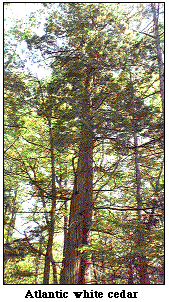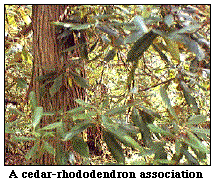Cedars are evergreen trees that are found in the same family as cypress trees and junipers.

The Atlantic white cedar (Chamaecyparis thyroides) has branchlets with small, bluish-green scales. Its bark is thin, and on mature trees is ash-grey to reddish-brown in color and has a "twisted" appearance. Trees may grow to be 80-85 feet tall. The geographic range for these trees is in the eastern coastal United States, ranging from Mississippi to Maine. In New Hampshire there are 30 recorded sites.
Atlantic white cedars grow primarily in freshwater bogs or swamps that are usually saturated with water during the growing season. The water is highly acidic and nutrient poor and has a low oxygen content. The floor of the swamps is covered by large quantities of sphagnum moss. The moss and other organic matter undergo slow decay and eventually become compressed. The cedars grow on "hummocks" or accumulations of this material, that is commonly known as peat.

In some instances, swamps containing Atlantic white cedars may be composed entirely of even-aged or mixed-aged trees of this species. In other cases, the swamps contain mixed stands. Red maples and black gum trees commonly accompany the Atlantic white cedars in the latter type of swamp. The swamps also contain a shrub "layer" and a herbaceous "layer." In New Hampshire, common shrubs are high bush blueberry, sweet pepperbush and winterberry holly; and characteristic herbs include pitcher plants and sundews, species that are unusual because they have the capability to capture and "digest" various insects. At least four species of ferns have been observed.
In its role as a wildlife habitat, a cedar swamp is home to various bird species. In New Hampshire, they include the red-shouldered hawk, barred owl, veery, Canada warbler, northern waterthrush and several others. The foliage of both mature trees and seedlings is a source of food for deer, rabbits, and meadow jumping mice.
On the Hackett Hill property,
Atlantic white cedar stands are found in approximately 9 locations.
The size of these swamps varies considerably and a given swamp may
contain either cedars alone, or mixed stands of trees where cedars
predominate. In most other locations, cedar swamps overlay deep
deposits of sand, but the Hackett Hill swamps lack these extensive
sand deposits. Instead the cedars are found in solid rock hollows
 and hence have very small watersheds.
The oldest cedars in this region are probably about 100 years old.
During the 1800s, when the region was largely agricultural, these
stands were heavily harvested for use in fence posts, poles, and
rails.
and hence have very small watersheds.
The oldest cedars in this region are probably about 100 years old.
During the 1800s, when the region was largely agricultural, these
stands were heavily harvested for use in fence posts, poles, and
rails.
In the largest AWC swamp, giant rhododendrons (Rhododendron maximum) grow in close proximity to the Atlantic white cedars and cinnamon ferns are abundant here. Sheep and mountain laurel are also present. Swamp azaleas (Rhododendron viscosum) are located in the second largest Atlantic white cedar swamp on the property.
In addition to these two rare Rhododendron species, the cedar swamps may be home to two endanged animal species. It is known that Hessel's Hairstreak butterfly larvae are dependent on the foliage of the Atlantic white cedar for their food supply, and that the adult butterflies obtain nectar from the highbush blueberry and sweet pepperbush that grow in the shrub layer of the cedar swamps. Also, it has been reported that the Ringed Boghaunter dragonfly may be found in some New Hampshire cedar swamps. The presence of these two species has not yet been documented on the Hackett Hill property, and studies should be done to investigate this possibility thoroughly.
![]() PERTINENT
LINKS
PERTINENT
LINKS